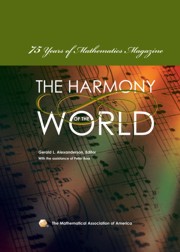Book contents
- Frontmatter
- Introduction
- Contents
- A Brief History of Mathematics Magazine
- Part I The First Fifteen Years
- Part II The 1940s
- Part III The 1950s
- Part IV The 1960s
- Generalizations of Theorems about Triangles
- A Radical Suggestion
- Topology and Analysis
- The Sequence {sin n}
- Probability Theory and the Lebesgue Integral
- On Round Pegs in Square Holes and Square Pegs in Round Holes
- π: 1832–1879
- Part V The 1970s
- Part VI The 1980s
- Briefly Noted
- The Problem Section
- Index
- About the Editors
The Sequence {sin n}
from Part IV - The 1960s
- Frontmatter
- Introduction
- Contents
- A Brief History of Mathematics Magazine
- Part I The First Fifteen Years
- Part II The 1940s
- Part III The 1950s
- Part IV The 1960s
- Generalizations of Theorems about Triangles
- A Radical Suggestion
- Topology and Analysis
- The Sequence {sin n}
- Probability Theory and the Lebesgue Integral
- On Round Pegs in Square Holes and Square Pegs in Round Holes
- π: 1832–1879
- Part V The 1970s
- Part VI The 1980s
- Briefly Noted
- The Problem Section
- Index
- About the Editors
Summary
Editors' Note: C. Stanley Ogilvy is Professor Emeritus of Mathematics at Hamilton College. Educated as an undergraduate at Williams College, he received his PhD from Syracuse University in 1954.
He is best known for his popular books Through the Mathescope (Oxford University Press, 1956), Tomorrow's Math/Unsolved Problems for the Amateur (Oxford, 1962), Excursions in Number Theory (with John T. Anderson) (Oxford,1966), and Excursions in Geometry (Oxford, 1969).
The following short proof is offered for the main result of the paper by John H. Staib and Miltiades S. Demos in Vol. 40, page 210 of this Magazine, namely that {sin n} is dense on [-1, 1].
Let the points whose polar coordinates (r, θ) are (1, 1), (1, 2), (1, 3), … be called integral points. Then the integral points are dense on the unit circle. For, assume that there exists an arc-length of magnitude ∈ > 0 such that between θ and θ + ∈ there are no integral points. Then there is another such gap whose initial point is at θ + 1, another whose initial point is at θ + 2, and so on. Two initial points can never coincide, or π would be rational. But an infinite number (indeed any finite number > (2π)/∈) of such gaps must cover the circle, so that the circle would contain no integral points, an absurdity.
The set {sin n} is a projection of the integral points onto the interval [-1, 1] of the Y -axis.
- Type
- Chapter
- Information
- Harmony of the World75 Years of Mathematics Magazine, pp. 121 - 122Publisher: Mathematical Association of AmericaPrint publication year: 2007

